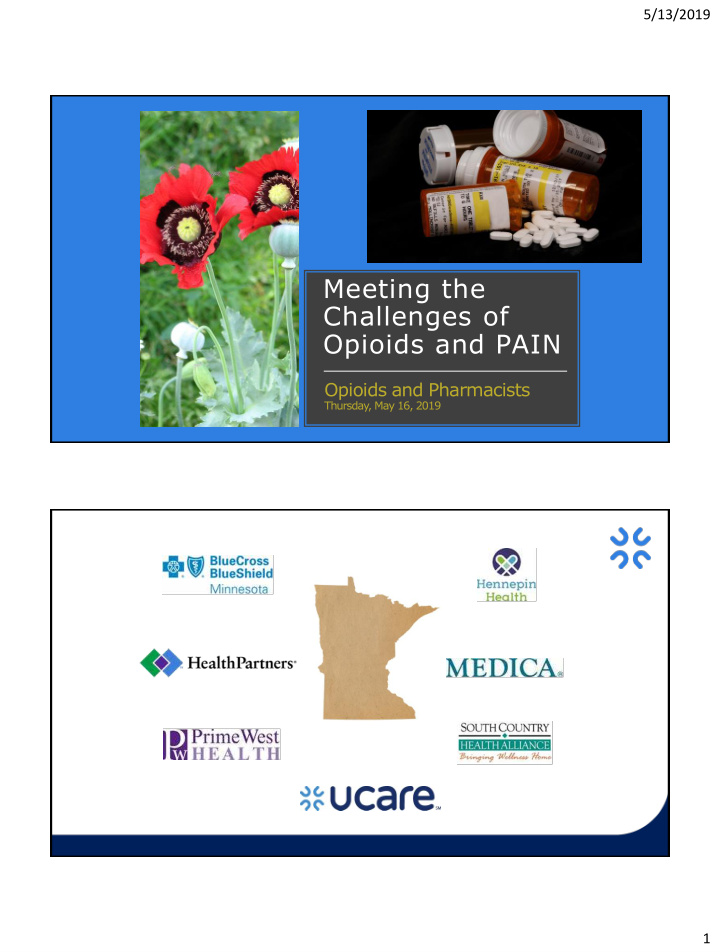



5/13/2019 Meeting the Challenges of Opioids and PAIN Opioids and Pharmacists Thursday , May 16, 2019 1
5/13/2019 A A Provide der r Too oolk lkit Meeting the Challenges of Opioids and PAIN: P ATIENT EDUCATION ON PAIN AND OPIOID PRESCRITIONS A DDRESSING OPIOID PRESCRIPTION PRACTICES I DENTIFYING SAFE AND EFFECTIVE PAIN MANAGEMENT PROTOCOLS N ONPHARMACOLOGIC AND NON-OPIOID PHARMACOTHERAPY ALTERNATIVES http://www.stratishealth.org/pip/opioids.html Table of Contents Introduction to the issue................................................................................................................. 2 Shared Decision Making ................................................................................................................. 4 Resources for Shared Decision Making ......................................................................................... 5 Resources for Patient Education about Pain and Opioids .............................................................. 7 Identifying Opioid Use Disorder or Drug Seeking Behavior ............................................................ 8 Resources for Opioid Use Disorder .............................................................................................. 9 Prescription Monitoring Programs ............................................................................................... 10 Effective Screening for Risk Factors .............................................................................................. 10 Continuing Medical Education and Training Opportunities ........................................................... 12 Non-Pharmacological Alternative Pain Management Therapies ................................................... 14 Resources for Non-Pharmacologic Interventions ........................................................................ 15 Tools for Pharmacists ................................................................................................................... 16 Patient Education ...................................................................................................................... 16 Proper Disposal ......................................................................................................................... 17 Considerations for the Elderly/Seniors ........................................................................................ 17 Considerations for Adolescents and Young Adults ........................................................................ 18 Safe Storage and Disposal of Prescription Opioids …..................................................................... 20 Pet Connection: Opioids Prescribed for Animals ........................................................................... 21 Appendix A ................................................................................................................................... 23 Resources from Other States and Related Topic Areas: ................................................................. 23 Bibliography ................................................................................................................................. 24 2
5/13/2019 Meeting the Challenges of Opioids and Pain: How Pharmacists are Working to Address the Opioid Crisis Erika Bower , PharmD, BCACP Objectives • Understand how guideline and regulatory changes have impacted pharmacy practice in multiple settings (community pharmacy, clinic settings, inpatient settings, etc.) • Describe pharmacist-led initiatives that have occurred to address the opioid crisis 6 3
5/13/2019 Opioid Epidemic More than 130 people die every day due to • opioid overdose (illicit and prescription) Prescription opioid misuse contributes to • economic burden of approximately $78.5 billion each year, which includes healthcare, lost productivity, addiction treatment, and criminal justice involvement 21-29% of patients prescribed opioids for • chronic pain misuse them and 8-12% will develop an opioid use disorder Amount of opioid prescriptions has quadrupled • from 1999-2014, however, there has not been an increase in the overall amount of pain that patients report 7 1. Opioid Overdose Crisis: National Institute on Drug Abuse. January 2019. Available at: https://www.drugabuse.gov/drugs-abuse/opioids/opioid-overdose-crisis 2. Dowell D, Haegerich TM, Chou R. CDC Guideline for Prescribing Opioids for Chronic Pain — United States, 2016. MMWR Recomm Rep 2016;65(No. RR-1):1 – 49. DOI: http://dx.doi.org/10.15585/mmwr.rr6501e1 Opioid Epidemic - Minnesota Opioid Dashboard • 422 Opioid overdose deaths in • 2017 – 195 involved prescription opioids – 111 involved heroin – 184 involved synthetic opioids (fentanyl, tramadol, etc.) – Continuing to rise 8 1. Opioids Data. Race Rate Disparity in Drug Overdose Deaths. Minnesota Department of Health. Available at: https://www.health.state.mn.us/communities/opioids/data/racedisparity.html 2. Minnesota Opioid Prescribing Guidelines. First Edition, 2018. Available at: https://mn.gov/dhs/opip/opioid-guidelines/ 3. https://www.health.state.mn.us/communities/opioids/opioid-dashboard/index.html 4
5/13/2019 Opioid Epidemic Minnesota Racial Disparities • – In 2016, African Americans were two times more likely to die of a drug overdose than whites – In 2016, American Indians were almost six times more likely to die of a drug overdose than whites 9 1. Opioids Data. Race Rate Disparity in Drug Overdose Deaths. Minnesota Department of Health. Available at: https://www.health.state.mn.us/communities/opioids/data/racedisparity.html 2. Minnesota Opioid Prescribing Guidelines. First Edition, 2018. Available at: https://mn.gov/dhs/opip/opioid-guidelines/ 3. https://www.health.state.mn.us/communities/opioids/opioid-dashboard/index.html Helpful Information Medication Therapy Management (MTM) • – Usually conducted by pharmacists – Variety of settings (Community, Ambulatory Care, Telehealth, etc.) – Assessment of all medications for appropriate indication, efficacy, safety, and convenience Collaborative Practice Agreement (CPA) agreement with prescriber to modify, • initiate, or discontinue medication therapy on the behalf of the prescriber. Can also be initiated to order labs or other appropriate referrals Naloxone – opioid antagonist medication. Quickly reverses effects of opioids from • the opioid receptor. Available in intranasal and injectable formulations Morphine Milligram Equivalent (MME) – value assigned to opioids to represent • relative potencies 10 1. Morphine Equivalent Dosing. RxPerts Industry Insights. Available at: https://www.wolterskluwercdi.com/sites/default/files/documents/ebooks/morphine-equivalent-dosing-ebook.pdf?v3 5
5/13/2019 • Administered by the MN Board of Pharmacy • State Board requires that pharmacists have access • Collects prescription data on all schedules II-V controlled substances as well as butalbital and gabapentin • Reported by pharmacies regardless of how prescription was paid for • Intent to reduce diversion and detect abuse and misuse • Can be accessed by pharmacists, prescribers, delegates of prescribers, medical examiners, MN Dept of Human Services Restricted Recipient Program staff and their delegates 11 http://pmp.pharmacy.state.mn.us/assets/files/2017%20Files/2017_FAQ_General%20ProgramIII.pdf CDC Guidelines • Intended for use by primary care physicians for chronic pain management in adults not related to palliative or active-cancer treatment • Non-pharmacologic therapy and non-opioid pharmacologic therapy are preferred • Consider opioid therapy only if benefits for pain and function are anticipated to outweigh risks. Should be in combination with other modalities • Close monitoring for functional improvement and opioid use risk - Check prescription drug monitoring programs regularly and utilize urine drug testing at least annually 12 1. Dowell D, Haegerich TM, Chou R. CDC Guideline for Prescribing Opioids for Chronic Pain — United States, 2016. MMWR Recomm Rep 2016;65(No. RR-1):1 – 49. DOI: http://dx.doi.org/10.15585/mmwr.rr6501e1 2. https://www.cdc.gov/drugoverdose/pdf/Guidelines_Factsheet-a.pdf 6
Recommend
More recommend